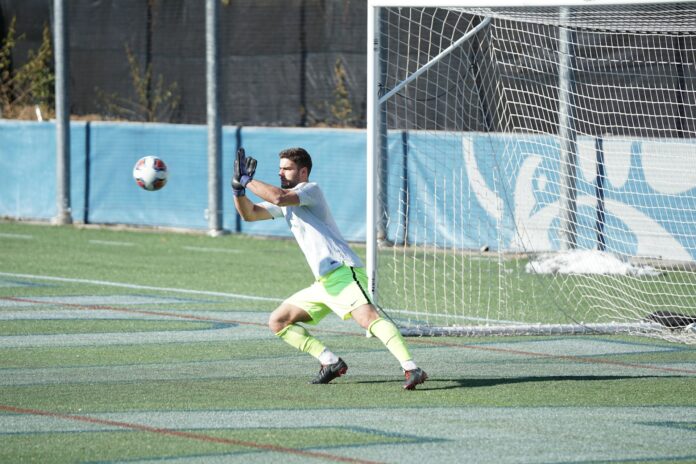The modern goalkeepers are no longer confined to the goal line, as mere shot-stoppers. Their role has expanded dramatically, demanding them to be playmakers, communicators, and even initiators of attacks. As football continues to accelerate in pace and tactical complexity, goalkeeper training must evolve beyond static, repetitive drills to mirror the dynamic realities of a match. This evolution points strongly towards game-based situation training.
Why Traditional Drills Fall Short
Traditionally, goalkeeper training was designed from Warmup to Final Game thus comprising of “exhausting individual drills, filled with endless shots without any break”. While fundamental techniques like handling, diving, and footwork are crucial, isolated drills often fail to replicate the split-second decision-making and unpredictable nature of live game situations. UEFA has turned this tradition on its head, instructing coaches to design their trainings from Game to Warmup, asserting that the true value of training comes when it presents “true distances, actual timing, game conditions”.
Insights from the 2022 World Cup: Understanding Match Realities
Recent analysis, including a study on goalkeeper performance in the 2022 FIFA World Cup, provides crucial insights into tailoring training strategies to specific shot locations. This research categorized 432 on-target shots from all 64 matches, examining factors like shot location, outcome, and preceding events. It highlighted that areas near the center of the goal (classified as ‘AN’ and ‘BN’) are particularly dangerous, leading to a significantly higher frequency of goals than expected.
These dangerous areas often see one-touch shots, especially from crosses, creating high time and spatial constraints for the goalkeeper. The ball moves quickly from the touchline to an area in front of the goal, requiring the goalkeeper to rapidly adjust position and perform actions in time with the shot. In contrast, areas farther from the goal (‘AF’, ‘BF’, ‘CF’) are less pressurized, with goalkeepers having more time to react. Shots from these ‘far’ areas often involve two or more touches after receiving a pass, allowing shooters more control and goalkeepers more time to adjust.
Tailoring Drills for Optimal Response
These findings underscore the need for training to be specifically tailored to different shot scenarios.
- For dangerous, high-pressure areas (like AN and BN), quick, reactive movements such as ‘blocking’ are paramount. Blocking allows goalkeepers to proactively approach the shooter and narrow the angle, prioritizing shot prevention.
- In less pressurized areas (AF, BF, CF), where there’s more time to react, techniques like ‘catching’ and ‘stepping and diving after preparatory motion’ are more frequently observed and effective. It is worth noting that “diving after preparatory motion” is the most frequently observed action by goalkeepers across all areas, suggesting its overall importance.
Technology and Team Play
To effectively implement Realistic training, modern tools are indispensable. Video analysis is an essential component, providing “objective criticism and personalized development plans”. Coaches can review subtle errors in posture or timing, and show goalkeepers the precise impact of their actions, turning mistakes into learning opportunities and enhancing self-esteem and motivation. Advanced technologies like motion capture and ball trajectory analysis can provide precise data on reactivity, agility, and technique.
Furthermore, integrating goalkeepers into full team drills is vital. As I elaborate in my book, Football Goalkeeper Integration, bringing the goalkeeper into team training “instantly every decision process involves a realistic picture for everyone: True distances, actual timing, game conditions”. This integrated approach ensures that goalkeepers develop not only their technical skills but also their tactical awareness, decision-making under pressure, and communication with outfield players. The goal is to create training sessions that don’t just maintain, but improve performance by working on weaknesses in game-like conditions.
A Holistic Approach to Goalkeeping Development
The physical demands on goalkeepers are unique, requiring specialized fitness regimes that focus on explosive movements, strength, agility, and balance. Moreover, the immense psychological demands of the position necessitate a focus on mental fortitude, with techniques like mindfulness and performance psychology coaching becoming integral to building resilience and confidence. For youth development, this means encouraging multi-sport participation for overall athleticism and promoting positional versatility to foster better game awareness.
Conclusion
By embracing realistic training, underpinned by detailed match analysis and full team integration, we can equip goalkeepers with the adaptability, decision-making prowess, and technical mastery required to thrive in the fast-paced, tactically complex world of modern football. This forward-thinking approach ensures our last line of defense is also a crucial first line of attack.
References:
- Numazu, N., Hirashima, Y., & Matsukura, K. (2024). Analysis of soccer goalkeeper performance and shot scenarios in the 2022 World Cup. Journal of Physical Education and Sport, 24(12), 2115-2125.
- Berneanou, G. (n.d.). Football Goalkeeper Integration. (e-book).
- Hugh, P. (2025, January 5). The Future of Goalkeeping: Trends and Innovations in Training. Soccer Wizdom.
- El Assouri, A. (n.d.). The role of video analysis in goalkeeper development. Keeper in Motion.

